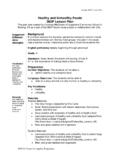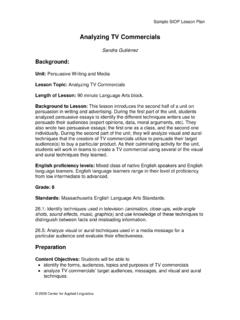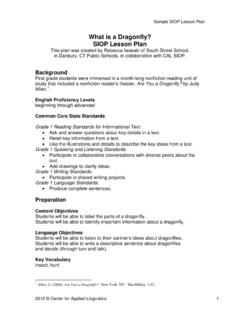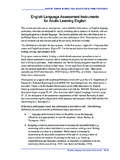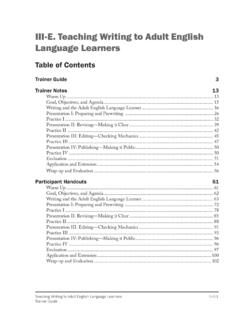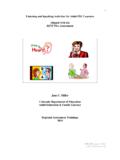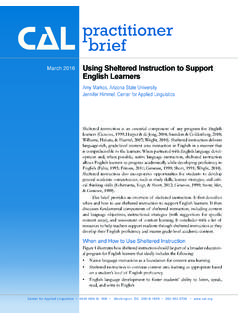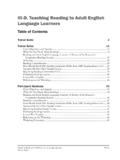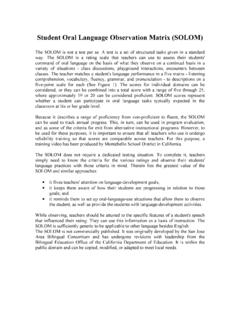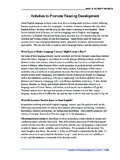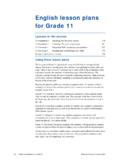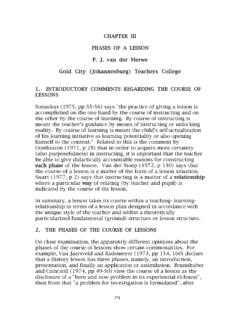Transcription of SIOP LESSON PLAN OUTLINE - Center for Applied Linguistics
1 CREATE siop Science Project: LESSON 12 Chemical Reactions siop LESSON plan LESSON TOPIC: Chemical Interactions UNIT FOCUS: Chemical Reactions LESSON # 12_ Length of LESSON _75-90 minutes (two periods) _ STATE SCIENCE STANDARDS: - Explain how activation energy is related to chemical reactions. - Identify factors that affect the rate of a chemical reaction. LESSON TOPIC: Controlling Chemical Reactions OBJECTIVES: Language Students will read a passage identify and discuss cause and effect. Students will make if-then statements in order to summarize what affects the rate of chemical reactions.
2 Content Students will perform a scientific investigation in order to observe chemical reactions, predict how substances will react when mixed, determine evidence of a reaction, and draw conclusions about chemical reactions. Students will identify what factors affect rates of reaction in order to explain how they do so. KEY VOCABULARY: activation energy, concentration, catalyst, enzyme, inhibitor, surface area, spoil, , when ___ happens, then ___ occurs MATERIALS: safety goggles, lab aprons, 125 mL of vitamin C solution at three temperatures, iodine, 3 plastic cups, spoon, two antacid tablets, two plastic cups, cold tap water, hot tap water, note cards, textbook and teachers edition of Science Explorer: Chemical Interactions (pp.)
3 69-71), graphic organizers: Catalyst/Inhibitor and Cause/Effect and Affecting the Rate of Chemical Reactions PREPARATION: 1. Make transparencies of the student versions of the Catalyst/Inhibitor and Cause/Effect graphic organizers. LESSON developed for the CREATE siop Science project. Used with permission. 2008 by the Center for Applied Linguistics and California State University, Long Beach. 1 CREATE siop Science Project: LESSON 12 Chemical Reactions 2. Decide on the number of groups for the Discover Activityi on p. 66 in Science Explorer: Chemical Interactions and organize supplies (safety goggles, lab aprons, 125 mL of vitamin C solution at three temperatures, iodine, 3 plastic cups, spoon, two antacid tables, two plastic cups, cold tap water, hot tap water) for groups.
4 - - - - - - - - - - - - - - - - - - - - - - - - - - - - - - - - - - - - - - - - - - - - - - - - - - - - - - - - - - - - - - MOTIVATION: (25 minutes) **Read and explain the content and language objectives of this LESSON to the students. Say, Let s look at our language objectives for today and then read language objectives aloud and discuss. Now let s look at our content objectives for today. Read content objectives aloud and discuss. Building Background: Have the students write down in their notebooks examples of endothermic and exothermic reactions they have used. Have them share out. Do the Building Background activity with students on page 66 of the textbook.
5 Have students consider the question, Why do we keep some foods in a refrigerator? using Compass Groups: - Put the students into groups of four. - Tell the groups to assign each member a different direction (north, south, east, or west). - Explain you will ask a question, then call out a direction. The student assigned that direction will answer. After several minutes, call on different directions to share what their group discussed. Record student responses and get students to infer that the lower temperature of the refrigerator slows down the decomposition process. Link this fact to the new concept for today: temperature is one of the factors that can slow down or speed up a chemical interaction.
6 Next ask the compass groups what will happen to a piece of food in your stomach if you take a small bite of an apple versus a large bite. Call on another direction and record student responses again. Get students to infer that food with smaller surface area will result in quicker digestion. Tell students surface area is another factor that affects the rate of a chemical reaction. Then ask the compass groups to consider what happens to frozen orange juice if you add only a half can of water. Call on another direction and record student responses. Get students to infer that the orange juice will be thicker and sweeter if less water is added. Tell students that concentration is the other factor that affects the rate of a chemical reaction.
7 Pre-teach the vocabulary term spoil. Have students make a vocabulary chart in their notebooks that includes the word, a picture, a definition in the student s own words, and a sentence for surface area, concentration, and spoil. Add to word wall. Preteach if-then statements. Ask the students what happens to food in the refrigerator if the electricity goes off. Collect responses and rephrase into an statement ( , If the electricity goes out, then the food goes bad or spoils.). Preteach the LESSON developed for the CREATE siop Science project. Used with permission. 2008 by the Center for Applied Linguistics and California State University, Long Beach. 2 CREATE siop Science Project: LESSON 12 Chemical Reactions sentence frame when___,then ___ occurs ( , When I chew my food into smaller pieces, then quicker digestion occurs.)
8 Preteach the terms inhibitors and catalysts. Explain that they are substances that affect the rate of reactions and point out the difference between inhibitors and catalysts by making an analogy. In their compass groups, ask the students to Think-Square-Share what factors might make traffic go slower ( , speed bumps, stop lights, cops) and what factors might make traffic go faster ( , time of day, no trucks or buses). Then make the analogy that things that slow traffic down are inhibitors and things that increase the flow of traffic are catalysts. Have students add these words to their vocabulary charts in the vocabulary section in their notebooks and add them to the word wall.
9 PRESENTATION: (25 minutes) Have students infer how surface area, concentration, inhibitors, catalysts, and temperature affect rates of reactions. Display the Cause and Effect chart and have students copy it into their notebooks. Give students a few minutes to silently read the section on pages 69-70 in the science text. Then, as a class, fill out the Cause and Effect chart. Once the chart is finished, ask students to use the information to formulate if-then statements. Model one if necessary. Display the Catalyst/Inhibitor transparency and have the students copy it into their notebooks. Then divide the students into two groups and assign one half of the students to read the Catalyst section on page 71 and the other half, Inhibitor.
10 Tell students to complete the part of the organizer that corresponds to their assigned section in the book. They may work with a partner who read the same section. Then tell the students to find someone in the class who read the section they did not. They should share information to complete the rest of their graphic organizers. Define the word enzyme. Have students add the word to their vocabulary chart in notebooks and add to the word wall. PRACTICE & APPLICATION: (15-20 minutes) Have students stay in compass groups and do Discover Activity on p. 66 of the textbook. For the Discover Activity, students work in groups. They are given three 125-mL solutions of vitamin C and water one at room temperature, one at about 75 C, and one chilled to between 5 C and 10 C.
